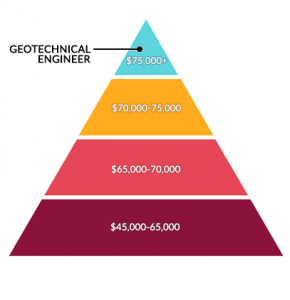The 15-Second Trick For Geotheta
Table of ContentsA Biased View of GeothetaOur Geotheta DiariesThe Best Strategy To Use For GeothetaWhat Does Geotheta Mean?Some Known Factual Statements About Geotheta

They carry out site examinations, accumulate examples, carry out lab examinations, and analyze information to examine the viability of the ground for construction jobs - Geo Tech Engineer. Based on their findings, geotechnical designers provide recommendations for structure design, incline security, keeping structures, and reduction of geotechnical hazards. They team up with various other specialists, such as architects, structural designers, and building teams, to guarantee that geotechnical factors to consider are incorporated right into the general job style and application
By analyzing the actions and residential or commercial properties of dirt and rock, they can recognize prospective geotechnical dangers such as landslides, soil negotiation, or incline instability. Their know-how helps avoid failings or crashes that might jeopardize lives and home. Right here are some comprehensive responsibilities and duties of a geotechnical engineer: Site Investigation: Geotechnical designers conduct site investigations to collect data on subsurface conditions.
They interpret the information to comprehend the properties and habits of the dirt and rock, including their strength, leaks in the structure, compaction attributes, and groundwater conditions. Geotechnical Evaluation and Layout: Geotechnical designers analyze the information accumulated during site investigations to assess the stability and viability of the site for building and construction tasks. They perform geotechnical computations and modeling to examine elements such as birthing capacity, negotiation, slope security, lateral planet stress, and groundwater circulation.
The Ultimate Guide To Geotheta
Foundation Style: Geotechnical engineers play a vital function in designing structures that can safely support the intended framework. They evaluate the dirt conditions and lots requirements to figure out the suitable structure kind, such as superficial foundations (e.g., grounds), deep structures (e.g (https://fliphtml5.com/homepage/bdjcx/geotheta/)., stacks), or specialized strategies like dirt renovation. They take into consideration aspects such as negotiation restrictions, bearing capability, and soil-structure interaction to develop optimum structure designs
They examine building strategies, screen website activities, and perform area assessments to validate that the layout suggestions are followed. If unexpected geotechnical concerns develop, they evaluate the situation and supply recommendations for remediation or modifications to the style. Risk Evaluation and Reduction: Geotechnical engineers assess geotechnical threats and risks related to the task website, such as landslides, liquefaction, or soil disintegration.

Partnership and Communication: Geotechnical designers work closely with other experts included in a project, such as designers, structural designers, and building and construction teams. Effective communication and collaboration are necessary to integrate geotechnical factors to consider into the total job design and building and construction process. Geotechnical engineers supply technical expertise, response queries, and make sure that geotechnical requirements are satisfied.
The Single Strategy To Use For Geotheta
Here are some types of geotechnical engineers: Foundation Engineer: Structure designers focus on developing and evaluating foundations for structures. They assess the soil conditions, lots needs, and website features to figure out one of the most ideal structure type and style, such as superficial foundations, deep foundations, or specialized strategies like pile foundations.
They evaluate the factors influencing slope stability, such as soil residential or commercial properties, groundwater problems, and incline geometry, and establish techniques to avoid slope failings and minimize threats. Earthquake Designer: Quake designers specialize in assessing and designing structures to endure seismic pressures. They examine the seismic risk of a website, examine dirt liquefaction potential, and create seismic design criteria to guarantee the safety and resilience of frameworks throughout quakes.
They perform field testing, collect examples, and analyze the gathered information to define the soil residential properties, geologic developments, and groundwater conditions at a site. Geotechnical Instrumentation Engineer: Geotechnical instrumentation designers concentrate on monitoring and gauging the actions of dirt, rock, and frameworks. They mount and preserve instrumentation systems that find this monitor aspects such as soil settlement, groundwater degrees, incline activities, and architectural variations to analyze performance and provide early cautions of prospective problems.
Geotheta Things To Know Before You Buy
They perform tests such as triaxial tests, loan consolidation tests, straight shear examinations, and permeability tests to collect information for geotechnical analysis and layout. Geosynthetics Engineer: Geosynthetics designers focus on the design and application of geosynthetic materials, such as geotextiles, geogrids, and geomembranes. They utilize these materials to enhance dirt stability, enhance inclines, give drainage options, and control erosion.
They often tend to be investigatory people, which implies they're intellectual, reflective, and investigative. They are interested, systematic, sensible, logical, and logical. Some of them are likewise social, implying they're kind, charitable, participating, patient, caring, helpful, understanding, tactful, and pleasant - Consulting Engineers.
In the office atmosphere, geotechnical engineers make use of specialized software application tools to carry out computations, develop styles, and examine data. They prepare records, evaluation job requirements, connect with customers and employee, and coordinate project activities. The workplace setting supplies a conducive atmosphere for study, evaluation, and cooperation with other specialists associated with the project.
Indicators on Geotheta You Need To Know
They frequently visit task sites to conduct site examinations, evaluate geotechnical conditions, and gather information for evaluation. These sees include traveling to various places, occasionally in remote or tough terrains. Geotechnical designers may do soil sampling, conduct examinations, and display building activities to make sure that the geotechnical elements of the task are being carried out properly.
Geotechnical designers also operate in specialized geotechnical research laboratories. In these centers, they perform experiments, perform tests on dirt and rock examples, and evaluate the design properties of the materials. Geotechnical lab engineers function thoroughly in these settings, handling testing equipment, running instruments, and tape-recording information. They collaborate with various other research laboratory team to guarantee precise and reputable screening outcomes.